Abstract
Objectives:
The aim of the present study was to formulate levocetirizine hydrochloride (LCD)-loaded chitosan nanoparticles at submicron level with high entrapment efficiency and prolonged effect for optimizing the plasma drug concentration enhancing bioavailability.
Materials and Methods:
LCD was successfully incorporated into chitosan nanoparticles by spray drying for the purpose of oral application. In vitro characteristics were evaluated in detail.
Results:
LCD was successfully loaded into the polymeric matrices by spray drying. Characterization of the nanoparticles including encapsulation efficiency, particle size, zeta potential, morphology, polydispersity index, solid-state characterizations, and LCD quantification by high performance liquid chromatography was performed. The release pattern of LCD from the nanoparticles was determined using a dialysis tube in simulated intestinal fluid (pH 6.8). In vitro release profiles indicated prolonged release of LCD from the nanoparticles that followed the Korsmeyer-Peppas kinetic model.
Conclusion:
Chitosan-based LCD-loaded polymeric nanoparticles appear to be a promising drug delivery system for the active agent.
Keywords: Levocetirizine dihydrochloride, chitosan, polymeric nanoparticle, spray drying
INTRODUCTION
Levocetirizine dihydrochloride (LCD) is an orally active, third generation nonsedative antihistaminic agent widely used in the treatment of chronic idiopathic urticaria, seasonal allergic rhinitis, and hay fever.1,2 It has more affinity for H1 receptors when compared to cetirizine hydrochloride (CD).1 LCD is rapidly and extensively absorbed after oral administration, with the peak plasma concentration attained in 0.9-1 h.3 LCD undergoes a low degree of first pass metabolism in the liver; it is metabolized to a limited extent by oxidative dealkylation to metabolite negligible antihistaminic activity. It is approximately 93% bound to plasma proteins and has a plasma elimination half-life of 8-9 h that does not change with multiple dosing.4 The fast disintegration behavior of conventional LCD formulations may result in initial burst-released kinetics, permitting the drug to be absorbed very quickly and resulting in high serum concentrations. Under these conditions, local irritation to gastrointestinal (GI) mucous membranes and other side effects such as drowsiness, tiredness, dry mouth, fever, cough, oculogyric crisis, and somnolence are inevitable.2,5 Therefore, it is desirable to design and develop a rational delivery system for LCD. Many efforts towards designing CD and LCD (active enantiomer of CD) sustained delivery systems by encapsulating, forming flexible vesicles, microparticles, and nanoparticles were made during the last decade.2,4,5,6 Nanoparticles have attracted considerable attention due to their advantageous properties such as decreased particle size, increased surface area, enhanced reactivity, promoted drug release, reformed targeting, reduced toxicity, and improved sustained-release efficacy.7 Surface charges of nanoparticles have a significant effect on internalization with cells and also on their uptake. Positively charged nanoparticles seem to allow a higher extent of internalization apparently as a consequence of ionic interactions established between cationic nanoparticles and negatively charged membranes.8 Chitosan is a polycationic polymer that is a naturally occurring polysaccharide found abundantly in marine crustaceans, insects, and fungi.9,10 Chitosan is composed of 2-amino-2-deoxy-β-D-glucan combined with glycosidic linkages.11 Positively charged amino groups of polymer interact with negatively charged biological membranes, ensuring a mucoadhesive character of the chitosan matrices.12 Chitosan is one of the most extensively studied materials in the pharmaceutical field. Properties such as biodegradability, low toxicity, good biocompatibility, and no risk of accumulation/retention in the body make it suitable for use in biomedical and pharmaceutical formulations.13 Spray drying is a single-step, cheap, continuous, and scalable process that enables the production of particles with controlled size and morphological aspects.14 Spray drying also eliminates the addition of crosslinking agent and minimizes the swelling of chitosan-based nanoparticles.15 Therefore, spray drying technology was utilized in the present study for the formulation of cationic nanoparticles using the advantages of the method. Our study may provide valuable information for the design and development of new LCD-loaded controlled-release dosage forms. The aim of the present study was to formulate positively charged LCD-loaded nanoparticles at submicron level with high encapsulation efficiency (EE), reduced local irritation to GI mucous membranes and other side effects, and prolonged plasma level drug concentration enhancing the bioavailability and protection of sensitive drugs against light thus improving their stability.
MATERIALS AND METHODS
Materials
The LCD was a kind gift from Neutec (İstanbul, Turkey). Chitosan (low molecular weight with 20-200 mPas.s viscosity) was purchased from Sigma (Steinheim, Germany). All other reagents used were of analytical grade.
Preparation of nanoparticles
Chitosan nanoparticles were prepared using a mini spray dryer (B-190, Buchi, Switzerland). The spray dryer was connected to an Inert Loop B-295 (Buchi, Switzerland) due to the organic solvent. Carbon dioxide gas was used at a flow rate of 120 L.min-1. The residual oxygen level in the system was kept below 4%. When preparing particulate systems by spray drying, it has to be kept in the mind that production parameters such as size of nozzle, feeding pump rate, inlet temperature, and compressed air flow rate affect particle size.15,16 It was reported that smaller particles are formed with a lower feeding pump rate and smaller nozzle size. In addition, smaller particles are formed with greater volume of air input where particle size is not dependent on inlet temperature in the range of 120-180°C.15 Therefore, the inlet temperature was maintained at 120°C using the slowest pump rate that can spray the solution.
Accurately weighed chitosan (1 g) was dissolved in acetic acid solution (2% v/v, 120 mL). Ethanol (96% v/v, 120 mL) was added to the acidic solution in order to decrease the viscosity of the chitosan solution. LCD was added to the mixture under constant stirrer speed (300 rpm) on a magnetic stirrer. The final clear solution was then spray dried with an inlet temperature of 120±1°C and outlet temperature of 60±5°C and delivered to a drying zone via a 4 µm nozzle. White dry powders were obtained and kept in tightly closed vials at room temperature until being analyzed. Placebo nanoparticles were prepared as described above without the addition of active agent.
The spray-drying conditions are shown in Table 1.
Table 1. Spray-drying conditions.

Characterization of nanoparticles
Morphology
The particle shape and surface characteristics of the freshly prepared nanoparticle formulations and LCD were investigated by scanning electron microscope (SEM) (Hitachi TM3030Plus Tabletop Microscope, Japan) at 25±2°C. Samples were coated with a thin layer of gold under argon to avoid charging under the electron beam.
Particle size and zeta potential
Particle size, polydispersity index (PI), and zeta potential measurements were carried out on freshly prepared samples using a Malvern Nano ZS (Zetasizer Nano Series, Malvern, Worcestershire, UK). Samples of all nanoparticles were dispersed in double distilled water (adjusted to a constant conductivity of 50 µS.cm-1 using 0.9% NaCl) just prior to analyses. All analyses were repeated in triplicate at 25±2°C. The data obtained were evaluated by span values calculated using volume distribution as diameter (d) values of 10%, 50%, and 90%. The diameter values indicate the percentage of particles possessing a diameter equal to or lower than the given value. The span value is a statistical parameter useful for evaluating the particle size distribution and calculated by the following equation:17
Span value=[d(90)-d(10)]/d(50) (1)
Differential scanning calorimetry
Structural and crystallinity changes in LCD and the polymer due to the thermal impacts during the formulation steps were evaluated using differential scanning calorimetry (DSC) (DSC-60, Shimadzu Scientific Instruments, Columbia, MI, USA). Analyses were performed under nitrogen at a flow rate of 50 mL.min-1 at 30-250°C with a rate of increase of 10°C.min-1.
Fourier transform infrared spectrophotometry
Fourier transform infrared (FT-IR) analysis spectra were recorded using a Shimadzu IR Prestige-21 (Shimadzu Corporation, Kyoto, Japan) at the wavelength range of 4000-500 cm-1.
Nuclear magnetic resonance spectroscopy
Nuclear magnetic resonance (NMR) spectroscopy (1H-NMR) analyses were performed using an UltraShield™ CPMAS NMR (Bruker, Rheinstetten, Germany). Samples were prepared by dissolving nanoparticles in deuterated dimethyl sulfoxide. Pure chitosan and LCD were analyzed by DSC, FT-IR, and 1H-NMR and were used as reference evaluating the interaction between polymer and LCD.
Determination of LCD
High performance liquid chromatography (HPLC) was used for the determination of LCD. A Shimadzu 20-A (Tokyo, Japan) equipped with a reversed phase Nucleosil 120-5 column (column diameter: 4.6 mm, column length: 250 mm, C18 gravity, 5 µm) was used. Acetonitrile: water: 1 M sulfuric acid (93:66:4, v/v/v) was used as mobile phase with a flow rate of 1 mL.min-1; 20 µL constant amount of samples injected via an automatic injector (Shimadzu, Tokyo, Japan) was used and a photodiode detector was used at 230 nm.18 Column temperature was set to 30°C. Validation studies were carried out for data reliability.
Encapsulation efficiency
In order to determine the amount of LCD in drug-loaded nanoparticles, drug EE was determined by validated HPLC method. Accurately weighed nanoparticles (5 mg) were dispersed in acetonitrile (1 mL), vortexed for 1 min, and centrifuged at 2500 rpm for 5 min for the determination of LCD remaining on the chitosan sphere surface (LCDs).12 The quantity of LCD encapsulated in nanoparticles was calculated as the difference between the amount initially added (LCDt) and the LCDs.5 Each experiment was repeated three times.
EE %=[(LCDt-LCDs)/LCDt]×100 (2)
In vitro drug release
A dialysis membrane method was used to identify the release behavior of nanoparticles. In vitro release profiles of LCD were investigated in freshly prepared simulated intestinal fluid (SIF, pH 6.8) over 72 h. Briefly, drug-loaded nanoparticles containing 1.5 mg of LCD were put in dialysis bags (with a molecular cut-off 12-14 kD, Sigma) and capped with closures. The bags were immersed into dissolution medium containing 80 mL of SIF at 37±1°C on a water bath using a continuous magnetic stirring rate of 100 rpm.7 Next 1-mL samples were withdrawn at predetermined time intervals and LCD contents in the receptor chamber were determined by HPLC and the release profile of pure LCD was used as a reference for better evaluation of the profiles. Sink conditions were maintained in the receptor compartment during the in vitro release studies. Each experiment was repeated three times.
In vitro release kinetics
Release kinetics were investigated using the software DDSolver in order to evaluate the mechanism of drug release from nanoparticles.19
RESULTS AND DISCUSSION
Different methods were used to prepare chitosan nanoparticles. The method chosen depended on factors such as particle size, thermal and chemical stability of the active agent, reproducibility of the release profiles, stability of the final product, and residual toxicity associated with the final product.11
Spray drying is a well-known technique to produce powders, granules, or agglomerates from mixtures of drug and excipient solutions as well as suspensions.15 In the present study, spray drying was chosen for preparing chitosan nanoparticles since it does not involve toilsome procedures and avoids the use of harsh cross-linking agents and organic solvents that might trigger chemical reactions with the active agent.11 The compositions of the chitosan nanoparticles prepared are given in Table 2.
Table 2. Compositions of nanoparticles prepared.
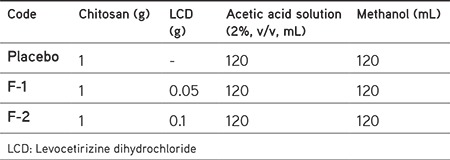
Characterization of nanoparticles
Morphology
SEM images of pure LCD and polymeric nanoparticles are given in Figure 1. The images showed that all formulations prepared were spherical.5 The placebo nanoparticles’ images resembled deflated balloons with wrinkled surfaces (Figure 1b), while the LCD-loaded spray-dried formulations demonstrated spherical shapes with the general morphology of spray-dried amorphous materials.12,20 The crystalline structure of LCD was not observed in the formulations, indicating successful incorporation of LCD into polymeric matrices.
Figure 1.
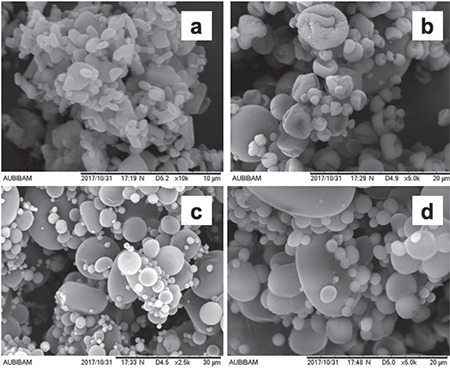
Scanning electron microscope images of pure LCD and formulations; a) LCD, b) placebo, c) F-1, d) F-2
LCD: Levocetirizine dihydrochloride
Particle size and zeta potential
Mean particle size, PI, and zeta potential values of the chitosan nanoparticles are presented in Table 3. The particle size and size distribution of nanoparticles play a key role in their adhesion and interaction with cells.7 Particle sizes of the nanoparticles were 521.70±8.50 nm and 538.46±5.74 nm for F-1 and F-2, respectively. It was found that the decrease in the amount of LCD in nanoparticles was in parallel with the relative decrease in average particle size.21 PI values were used to define the particle size distribution. All prepared nanoparticles were nanometer sized and the size distributions were relatively monodisperse with PI values of 0.512±0.090 and 0.498±0.074 for F-1 and F-2, respectively. PI values higher than 0.7 are indicative of a very large particle size distribution.22,23 All nanoparticles prepared in the present study had PI values lower than 0.7; therefore, particle size distribution was uniform.
Table 3. Mean particle size, PI, zeta potential of formulations prepared (n=3).
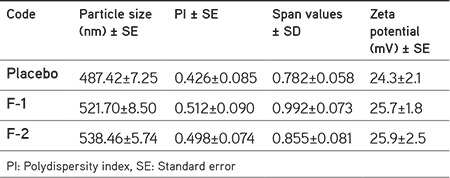
The span index measures the width of the particle size distribution, as described in the literature.24 Formulations show a relatively narrow particle size distribution (span index <1). The narrower size distribution reported previously was confirmed by the span values, i.e. the lower span the narrower the particle size distribution.17 Zeta potential is a scientific notion for electrokinetic potential in colloidal systems and is one of the most important properties, playing a major role in the efficiency of nanomedicine. Zeta potential can affect the physical and pharmacokinetic properties of nanosystems in the body or may affect the phagocytosis of nanoparticles in the blood stream.25 The results showed that zeta potentials were 25.7±1.8 mV and 25.9±2.5 mV for F-1 and F-2, respectively, which may be attributed to the positive charges on polymeric matrices, indicating adequate physical stability. Considering negatively charged cell membranes, cationic nanoparticles have great potential in the enhancement of internalization with the cells and also on their uptake.15,26
Differential scanning calorimetry
Thermodynamic variations related to morphological changes during and after the formulation steps can be detected by thermal analysis.27 Figure 2 displays the thermal behavior of the LCD and nanoparticles prepared. Pure LCD demonstrated an endothermic peak at 228°C, showing a crystalline structure.28 According to DSC analyses, no endothermic peaks were revealed in the thermograms of the nanoparticles prepared, showing the amorphous state of the polymeric lattice. The disappearance of LCD peaks in all thermograms of nanoparticles prepared indicated that LCD was molecularly dispersed in the polymeric structure.7,21,23
Figure 2.
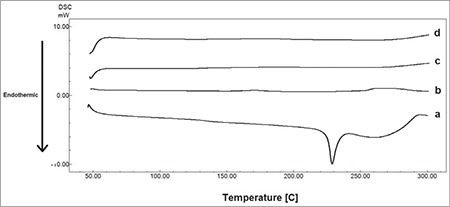
Differential scanning calorimetry thermograms of pure LCD and formulations; a) LCD, b) placebo, c) F-1, d) F-2
LCD: Levocetirizine dihydrochloride, SD: Standard deviation
Fourier transform infrared spectrophotometry
FT-IR spectroscopy reveals information about the molecular interactions of chemical components and is beneficial for assessing microstructural changes in the polymeric structure.29
The FT-IR spectrum of LCD showed bands assigned to the aromatic -CH (3110-3000 cm-1) and aliphatic -CH2 (2985.6-2914.2 cm-1). While the OH dimer of the amino-carboxylic acid appeared at 2628.98 cm-1, the tertiary amine salt was observed at 2349.30 cm-1 (Figure 3). The absorption bands at 1745.58 cm-1 and 1600.32 cm-1 were a result of the carbonyl group and phenyl nucleus skeletal stretching, respectively. The presence of two adjacent benzene rings was shown at 844.8-808.1 cm-1. While the carboxylic C-O bond frequency was observed at 1463-1263 cm−1, the aliphatic chain C-O bond in CH2CH2OCH2COOH appeared at 1180.4 cm-1 and at 758 cm-1.30 The placebo formulation showed similar absorption bands with pure chitosan. The FT-IR spectrum of the placebo formulation showed characteristic absorption bands at 3352, 2918, and 2850 cm-1, which represent -OH, -CH2, and CH3 aliphatic groups, and bands at 1558 and 1417 cm-1 represent the -NH group bending vibration and vibrations of the -OH group of the primary alcohol, respectively. The amino group has a characteristic band at 3400-3500 cm-1 that is concealed by the broad absorption band of the -OH group.31 Distinctive peaks of LCD were not seen in the spectra of F-1 or F-2 formulations, indicating the molecular dispersion of LCD in the polymeric matrices, which was supported by the DSC results.7 The absence of LCD distinctive peaks confirmed encapsulation of the drug within the polymeric structure.6
Figure 3.
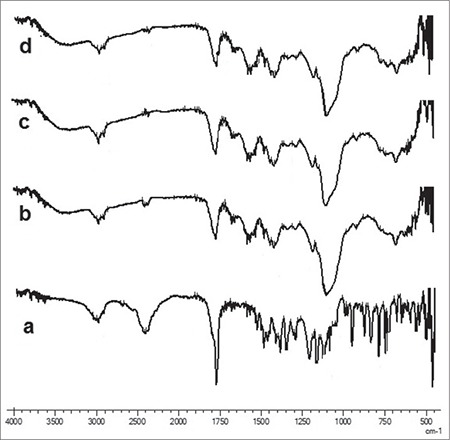
Fourier transform infrared spectra of pure LCD and formulations; a) LCD, b) placebo, c) F-1, d) F-2
LCD: Levocetirizine dihydrochloride
Nuclear magnetic resonance spectroscopy
The physicochemical properties of nanoparticles can be identified by NMR analysis in a variety of dosage forms to elucidate the status of active agent incorporated into matrices, its molecular mobility, and molecular interactions between the active agent and the excipients.12 Peaks appeared in the broad multiplet between 7 and 8 ppm belonging to peaks of 16 aromatic CH protons and 2 NH protons (Figure 4).32 A singlet was observed at 3.33 ppm for the methyl diphenyl CH proton. A triplet at 3.83 ppm was obvious due to four protons on the acyclic CH2 groups. Another singlet at 3.51 ppm with two protons was shown for the CH2 in CH2CH2O entity. The CH2 in the CH2COOH group appeared as a singlet at 3.73 ppm. A very weak singlet was present at 10.6 ppm for the one proton of the carboxylic acid group.33 Some characteristic peaks of LCD were found also in the spectra of nanoparticle formulations, indicating successful incorporation of drug into the nanoparticles with no chemical changes.34 The data were also supported by the DSC and FT-IR results.
Figure 4.
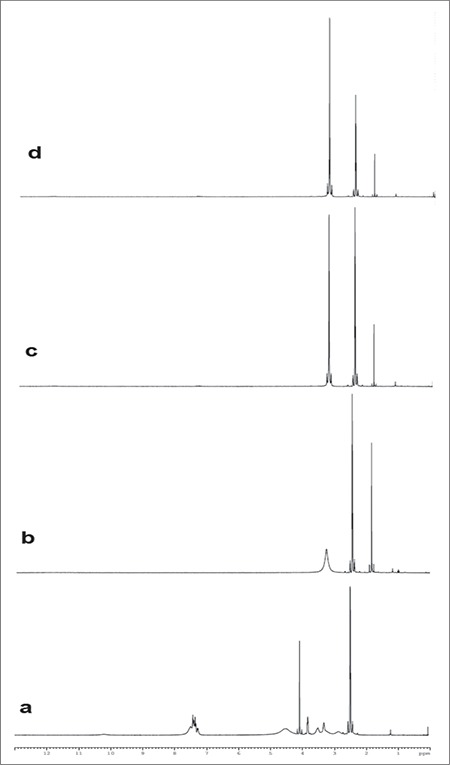
Nuclear magnetic resonance spectra of pure LCD and formulations; a) LCD, b) placebo, c) F-1, d)
F-2 LCD: Levocetirizine dihydrochloride
Determination of LCD
The analytical process validation method of the International Harmonization Committee was used in the present study. The method was validated for linearity, accuracy, precision, sensitivity, and specificity with reference to the guidelines.35 The separation and resolution of the LCD from formulations could be achieved using a mixture of acetonitrile:water:1 M sulfuric acid (93:66:4, v/v/v) as the mobile phase with UV detection at 230 nm.18 The calibration curve was constructed by plotting the peak area ratio (y) of the LCD concentration. The linearity of the method was examined in the range of 2.5-250 µg.mL-1 and the calibration curve was chosen in this range (Figure 5). Good fit of the equation was found, y=2398.3252x+6416.2523, with a correlation coefficient of 0.9996. The limit of detection (LOD) and limit of quantification (LOQ) values were 0.7968 µg.mL-1 and 2.4146 µg.mL-1, respectively. Accuracy is the similarity of the test results obtained by the analytical method to the true values. It was reported that recovery values must be in the range of 98%-102% to decide on the accuracy of the method used. The HPLC method used in this study yielded high recovery values (98%-100%) (Table 4), which indicated the accuracy of the method used. Measurements obtained with three different concentrations (low, medium, and high) evaluating repeatability and reproducibility of the analytical method used seem to verify the precision of the method since the percentage of relative standard deviation (RSD) was below 2%, which is within the targeted interval (Table 5).36 Meanwhile this method was specific for the determination and quantification of LCD. The method validation conducted proved the accuracy, reliability, and specificity of the method. It was found that all the results of the present coefficient of variation are below 2%, showing the method was valid.37,38
Figure 5.
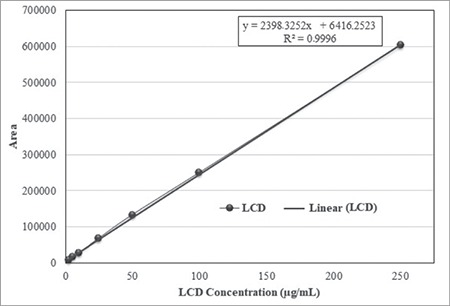
Calibration curve of levocetirizine dihydrochloride
LCD: Levocetirizine dihydrochloride
Table 4. Accuracy and recovery results.
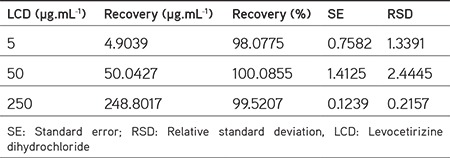
Table 5. Interday and intraday precision results.
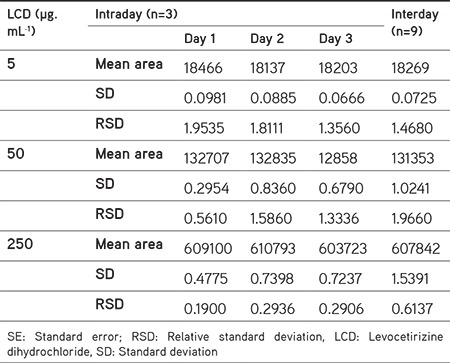
Encapsulation efficiency
The EE is the percentage of the amount of the drug loaded into polymeric matrices. In the present study, EE % was 71.37±1.32 and 67.328±2.09 (EE % ± SE) for F-1 and F-2, respectively. Drug-polymer composition is most likely one of the reasons for the in vitro release rate; however, it seems that a complex phenomenon between active agent and polymer molecules may occur, including entrapment of drug within the polymeric network and the adsorption of drug molecules on the surface of polymeric matrices as a result of electrostatic adhesion.39,40
In vitro drug release
Dissolution testing has been recognized as an important tool for both drug development and quality control.41 It can be used not only as a primary tool to monitor the consistency and stability of drug products but also as a relatively rapid and inexpensive technique to predict in vivo absorption of a drug formulation.19 The release profiles obtained from chitosan nanoparticles are given in Figure 6. The release profile of pure LCD was used as reference. LCD release from nanoparticles was much slower than that of its pure form, showing a time-dependent release manner in release media. Moreover, there was no significant difference between F-1 and F-2 formulations as stated by the release profiles (p>0.05).21 The release rate was not affected significantly by increasing the amount of LCD used in the nanoparticles. Moreover, drug release was extended more than 2-fold with nanoparticles, which enhances their possible use for better treatment.
Figure 6.
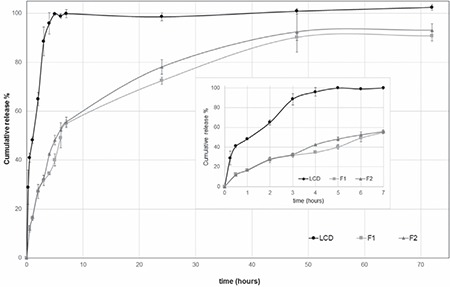
In vitro release profiles of levocetirizine dihydrochloride from nanoparticles prepared (n=3) (mean ± standard error)
In vitro release kinetics
Quantitative evaluation of drug dissolution characteristics is of great interest to pharmaceutical scientists. Drug release data were evaluated using many mathematical and statistical parameters.19
Fitting in vitro release profiles to mathematical models describing drug release as a function of time gives valuable data about the in vivo release behavior of optimal delivery systems.42 Therefore, in vitro release kinetics were also evaluated for nanoparticles in comparison with pure LCD using DDSolver.19
In vitro dissolution data were transferred to DDSolver to determine five important and the most popular criteria. These criteria were based on the coefficient of determination (Rsqr, R2, or COD), the adjusted coefficient of determination (R2 adjusted), the Akaike information criterion (AIC), the model selection criterion (MSC), and n for only Korsmeyer–Peppas models. The highest R2, R2 adjusted, and MSC values and the lowest AIC values were used for the evaluation of the best fitted models.19,43 Zero-order kinetics, first-order kinetics, Higuchi, Hixson–Crowell, Korsmeyer–Peppas, and Hopfenberg models were selected for evaluation in DDSolver. The majority of these models usually have nonlinear equations. DDSolver has been developed to utilize the hardships encountered in comparing free profiles with several different dissolution parameters for eliminating many experimental mistakes and the other mistakes due to the user.19 The R2, R2 adjusted, MSC, and AIC values obtained as a result of applying in vitro release study data to different kinetic models using DDSolver are shown in Table 6. Release of pure LCD fit best the first-order model, where drug release is concentration dependent. In vitro release from chitosan nanoparticles fit best the Korsmeyer–Peppas model according to all the criteria. This model indicates diffusion controlled release from a polymeric matrix nano-system developed.9,23 ‘n’ is the diffusional release exponent that could be used to characterize the different release mechanisms [n≤0.45 (Fickian diffusion), 0.45<n<1 (anomalous transport), and n=1 (case II transports; i.e. zero-order release)]. The Korsmeyer–Peppas equation proposed that release of LCD from the polymeric matrices was through Fickian diffusion (n=0.290 and n=0.420 for F-1 and F-2, respectively). This information suggests that LCD release from the nanoparticles was through diffusion.44
Table 6. Release kinetic modeling of levocetirizine dihydrochloride-loaded nanoparticles.
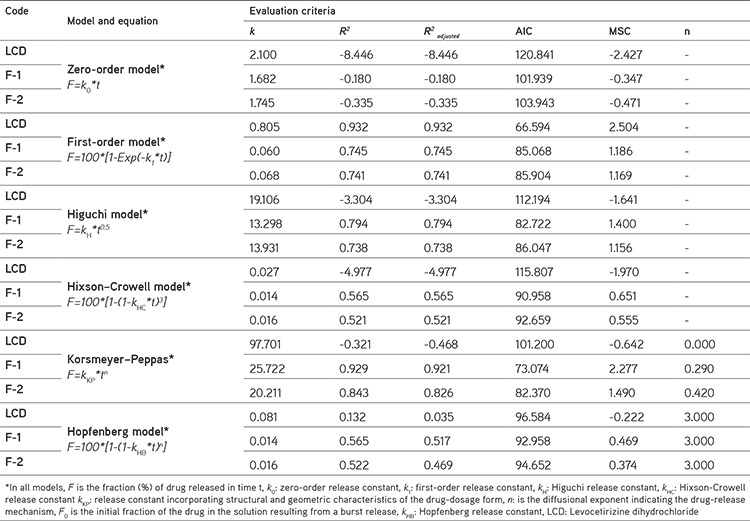
CONCLUSION
In this study, LCD was used as a model drug to be entrapped in a natural biodegradable material (chitosan) using spray drying. The results of analyses demonstrated that nanometer-sized spherical nanoparticles were achieved with this technique. Moreover, the nanoparticles showed a narrow size distribution, cationic characteristic, and relatively high EE. Solid state characterization studies such as DSC, FT-IR, and 1H-NMR confirmed the successful incorporation into the polymeric matrices. It was shown that all nanoparticles displayed a prolonged release pattern without a burst effect in comparison with the pure drug. According to the criteria, formulations were fitted to the Korsmeyer–Peppas model demonstrating the diffusion mechanism of polymeric matrices. In vitro studies showed that cationic chitosan nanoparticles containing LCD are effective carrier candidates for reducing local irritation to GI membranes and other side effects and optimizing plasma drug concentration improving bioavailability and protection of sensitive drugs against light, thus also improving their stability. However, in vivo analyses are required for a final decision to be made.
Acknowledgments
The authors would like to thank BIBAM (Anadolu University) management for the spray dryer equipment and Exp. Serkan Levent (DOPNA-LAB, Anadolu University) for FT-IR and NMR studies.
Footnotes
Conflicts of interest: No conflict of interest was declared by the authors.
References
- 1.Prabhu P, Malli R, Koland M, Vijaynaryana K, D’Souza U, Harish NM, Shastry CS, Charyulu RN. Formulation and evaluation of fast dissolving films of levocetirizine dihydrochloride. Int J Pharm Investig. 2011;1:99–104. doi: 10.4103/2230-973X.82417. [DOI] [PMC free article] [PubMed] [Google Scholar]
- 2.Goindi S, Kumar G, Kaur A. Novel flexible vesicles based topical formulation of levocetirizine: in vivo evaluation using oxazolone-induced atopic dermatitis in murine model. J Liposome Res. 2014;24:249–257. doi: 10.3109/08982104.2014.899365. [DOI] [PubMed] [Google Scholar]
- 3.Takahashi H, Ishida-Yamamato A, Iizuka H. Effects of bepotastine, cetirizine, fexofenadine, and olopatadine on histamine-induced whealand flare-response, sedation, and psychomotor performance. Clin Exp Dermatol. 2004;29:526–532. doi: 10.1111/j.1365-2230.2004.01618.x. [DOI] [PubMed] [Google Scholar]
- 4.El-Say KM, El-Hewl ARM, Ahmed OAA, Hosny KM, Ahmed TA, Kharshoum RM, Fahmy UA, Alsawahli M. Statistical optimization of controlled release microspheres containing cetrizine hydrochloride as a model for water soluble drugs. Pharm Dev Technol. 2015;20:738–746. doi: 10.3109/10837450.2014.920353. [DOI] [PubMed] [Google Scholar]
- 5.Li F, Ji R, Chen X, You B, Pan Y, Su J. Cetrizine dihydrochloride loaded microparticles design using ionotropic cross-linked chitosan nanoparticles by spray-drying method. Arch Pharm Res. 2010;33:1967–1973. doi: 10.1007/s12272-010-1212-3. [DOI] [PubMed] [Google Scholar]
- 6.Vino S, Preethi LR, Gopika M, Ghosh AR. Controlled release formulation of levocetirizine dihydrochloride by casein microparticles. Afr J Pharm Pharmaco. 2013;7:1046–1053. [Google Scholar]
- 7.Yurtdaş-Kırımlıoğlu G, Yazan Y. Formulation and in vitro characterization of polymeric nanoparticles designed for oral delivery of levofloxacin hemihydrate. Euro Int J Sci Technol. 2016;5:148–157. [Google Scholar]
- 8.Foged C, Brodin B, Frokjaer S. Particle size and surface charge affect particle uptake by human dendritic cells in an in vitro model. Int J Pharm. 2005;298:315–322. doi: 10.1016/j.ijpharm.2005.03.035. [DOI] [PubMed] [Google Scholar]
- 9.Dash M, Chiellini F, Ottenbrite RM, Chiellini E. Chitosan - a versatile semi-synthetic polymer in biomedical applications. Prog Polym Sci. 2011;36:981–1014. [Google Scholar]
- 10.Vino S, Paryani P, Sajitha LS, Ghosh AR. Formulation and evaluation of chitosan beads of levocetirizine dihydrochloride. J Appl Pharm Sci. 2012;2:221–225. [Google Scholar]
- 11.Agnihotri SA, Mallikarjuna NN, Aminabhavi TA. Recent advances on chitosan-based micro-and nanoparticles in drug delivery. J Control Release. 2004;100:5–28. doi: 10.1016/j.jconrel.2004.08.010. [DOI] [PubMed] [Google Scholar]
- 12.Başaran E, Yenilmez E, Berkman MS, Büyükköroğlu G, Yazan Y. Chitosan nanoparticles for ocular delivery of cyclosporine A. J Microencapsul. 2014;31:49–57. doi: 10.3109/02652048.2013.805839. [DOI] [PubMed] [Google Scholar]
- 13.Sinha VR, Singla AK, Wadhawan S, Kaushik R, Kumria R, Bansal K, Dhawan S. Chitosan microspheres as a potential carrier for drugs. Int J Pharm. 2004;274:1–33. doi: 10.1016/j.ijpharm.2003.12.026. [DOI] [PubMed] [Google Scholar]
- 14.Re M. Formulating drug delivery systems by spray drying. Dry Technol. 2006;24:433–446. [Google Scholar]
- 15.He P, Davis SS, Illum L. Chitosan microspheres prepared by spray drying. Int J Pharm. 1999;187:53–65. doi: 10.1016/s0378-5173(99)00125-8. [DOI] [PubMed] [Google Scholar]
- 16.Corrigan DO, Healy AM, Corrigan OI. Preparation and release of salbutamol from chitosan and chitosan co-spray dried compacts and multiparticulates. Eur J Pharm Biopharm. 2006;62:295–305. doi: 10.1016/j.ejpb.2005.09.008. [DOI] [PubMed] [Google Scholar]
- 17.Teeranachaideekul V, Souto EB, Junyaprasert VB, Müller RH. Cetyl palmitate-based NLC for topical delivery of Coenzyme Q10 - development, physicochemical characterization and in vitro release studies. Eur J Pharm Biopharm. 2007;67:141–148. doi: 10.1016/j.ejpb.2007.01.015. [DOI] [PubMed] [Google Scholar]
- 18.USP (The United States Pharmacopeia), Levocetirizine Dihydrochloride, 2017. Available from: [Internet] http://www.uspnf.com/sites/default/files/usp_pdf/EN/USPNF/iras/levocetirizine-dihydrochloride-m3460-ira.pdf .
- 19.Zhang Y, Huo M, Zhou J, Zou A, Li W, Yao C, Xie S. DDSolver: an add-in program for modelling and comparison of drug dissolution profiles. AAPS Journal. 2010;12:263–271. doi: 10.1208/s12248-010-9185-1. [DOI] [PMC free article] [PubMed] [Google Scholar]
- 20.Sormoli ME, Islam MIU, Langrish TAG. The effect of chitosan hydrogen bonding on lactose crystallinity during spray drying. J Food Eng. 2012;108:541–548. [Google Scholar]
- 21.Yenilmez E, Yurtdaş-Kırımlıoğlu G, Şenel B, Başaran E. Preparation, characterization and in vitro evaluation of dirithromycin loaded Eudragit RS 100 nanoparticles for topical application. Lat Am J Pharm. 2017;36:2203–2212. [Google Scholar]
- 22.Lopedota A, Trapani A, Cutrignelli A, Chiarantini L, Pantucci E, Curci R, Manuali E, Trapani G. The use of Eudragit RS 100/cyclodextrin nanoparticles for the transmucosal administration of glutathione. Eur J Pharm Biopharm. 2009;72:509–520. doi: 10.1016/j.ejpb.2009.02.013. [DOI] [PubMed] [Google Scholar]
- 23.Öztürk AA, Yenilmez E, Arslan R, Şenel B, Yazan Y. Dexketoprofen trometamol-loaded Kollidon® SR and Eudragit® RS 100 polymeric nanoparticles: formulation and in vitro-in vivo evaluation. Lat Am J Pharm. 2017;36:2153–2165. [Google Scholar]
- 24.Tan CP, Nakajima M. β-Carotene nanodispersions: preparation, characterization and stability evaluation. Food Chem. 2005;92:661–667. [Google Scholar]
- 25.Honary S, Zahir F. Effect of zeta potential on the properties of nano-drug delivery systems - a review (part 1) Trop J Pharm Res. 2013;12:255–264. [Google Scholar]
- 26.Radomska-Soukharev A. Stability of lipid excipients in solid lipid nanoparticles. Adv Drug Deliver Rev. 2007;59:411–418. doi: 10.1016/j.addr.2007.04.004. [DOI] [PubMed] [Google Scholar]
- 27.Castelli F, Puglia C, Sarpietro MG, Rizza L, Bonina F. Characterization of indomethacin-loaded lipid nanoparticles by differential scanning calorimetry. Int J Pharm. 2005;304:231–238. doi: 10.1016/j.ijpharm.2005.08.011. [DOI] [PubMed] [Google Scholar]
- 28.Choudhury P, Deb P, Dash S. Formulation and statistical optimization of bilayer sublingual tablets of levocetirizine hydrochloride and ambroxol hydrochloride. Asian J Pharm Clin Res. 2016;9:228–234. [Google Scholar]
- 29.Saito Y, Iwata T. Characterisation of hydroxyl groups of highly crystalline-chitin under static tension detected by FT-IR. Carbohydr Polym. 2012;87:2154–2159. [Google Scholar]
- 30.Kenawi IM, Barsoum BM, Youssef MA. Drug-drug interaction between diclofenac, cetirizine and ranitidine. J Pharm Biomed Anal. 2005;37:655–661. doi: 10.1016/j.jpba.2004.10.051. [DOI] [PubMed] [Google Scholar]
- 31.Sionkowska A, Wisniewski M, Skopinska J, Kennedy CJ, Wess TJ. Molecular interactions in collagen and chitosan blends. Biomaterials. 2004;25:795–801. doi: 10.1016/s0142-9612(03)00595-7. [DOI] [PubMed] [Google Scholar]
- 32.Ali SM, Upadhyay SK, Maheshwari A. NMR spectroscopic study of inclusion complexes of cetirizine dihydrochloride and β-cyclodextrin in solution. Spectroscopy. 2007;21:177–182. [Google Scholar]
- 33.Shamshad H, Arayne MS, Sultana N. Spectroscopic characterization of in vitro interactions of cetirizine and NSAIDS. J Anal Sci Technol. 2014;5:1–8. [Google Scholar]
- 34.Yurtdaş-Kırımlıoğlu G, Yazan Y. Development, characterization and in vitro release characteristics of rabeprazole sodium in halloysite nanotubes. Euro Int J Sci Technol. 2016;5:99–109. [Google Scholar]
- 35.ICH, Q2R1 2005. Harmonised Tripartite Guideline, Validation of Analytical Procedure: Text and Methodology, Complementary Guideline on Methodology, in: Proceedings of the International Conference on Harmonization, Canada. Available from: [Internet] https://www.ema.europa.eu/en/documents/scientific-guideline/ich-q-2-r1-validation-analyticalprocedures-text-methodology-step-5_en.pdf .
- 36.Shabir GA. Validation of high-performance liquid chromatography methods for pharmaceutical analysis. Understanding the differences and similarities between validation requirements of the US Food and Drug Administration, the US Pharmacopeia and the International Conference on Harmonization. J Chromatogr A. 2003;987:57–66. doi: 10.1016/s0021-9673(02)01536-4. [DOI] [PubMed] [Google Scholar]
- 37.Yurtdaş-Kırımlıoğlu G, Yazan Y. Determination of gamma-aminobutyric acid by HPLC: its application to polymeric nanoparticles and stability studies. Int J Develop Res. 2016;6:8277–8282. [Google Scholar]
- 38.Öztürk AA, Yenilmez E, Yazan Y. Development and validation of high performance liquid chromatography (HPLC) modified method for dexketoprofen trometamol. Euro Int J Sci Technol. 2017;6:33–41. [Google Scholar]
- 39.Adibkia K, Javadzadeh Y, Dastmalchi S, Mohammadi G, Niri FK, Alaei- Beirami M. Naproxen-Eudragit® RS100 nanoparticles: preparation and physicochemical characterization. Colloids Surf B Biointerfaces. 2011;83:155–159. doi: 10.1016/j.colsurfb.2010.11.014. [DOI] [PubMed] [Google Scholar]
- 40.Thagele R, Mishra A, Pathak AK. Formulation and characterization of clarithromycin based nanoparticulate drug delivery system. Int J Pharm Life Sci. 2011;2:510–515. [Google Scholar]
- 41.Zuo J, Gao Y, Bou-Chacra N, Löbenberg R. Evaluation of the DDSolver software applications. Biomed Res Int. 2014;ArticleID204925:1–9. doi: 10.1155/2014/204925. [DOI] [PMC free article] [PubMed] [Google Scholar]
- 42.Costa P, Sousa Lobo JM. Modeling and comparison of dissolution profiles. Eur J Pharm Sci. 2001;13:123–133. doi: 10.1016/s0928-0987(01)00095-1. [DOI] [PubMed] [Google Scholar]
- 43.Victor OB, Francis OA. Evaluation of the kinetics and mechanism of piroxicam release from lipophilic and hydrophilic suppository bases. Int J ChemTech Res. 2017;10:189–198. [Google Scholar]
- 44.Sharma UK, Verma A, Prajapati SK, Pandey H, Pandey AC. In vitro, in vivo and pharmacokinetic assessment of amikacin sulphate laden polymeric nanoparticles meant for controlled ocular drug delivery. Appl Nanosci. 2015;5:143–155. [Google Scholar]


